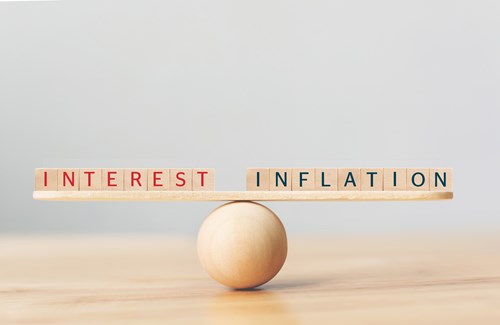
Ravenscroft CIO Kevin Boscher looks back at the macro landscape of 2023 and where the opportunities could come in 2024.
After another difficult year for the global economy and financial markets, both bonds and equities have rallied strongly since the end of October in anticipation of a more dovish Federal Reserve (Fed) and lower interest rates next year. We have been here before and markets have been disappointed several times over the past couple of years by either stubbornly persistent inflation or the resultant “higher for longer” policy of central banks. However, this time seems for real as inflation is falling rapidly almost everywhere, global growth is slowing, labour market tightness is easing, and the Fed is openly contemplating lower rates. The global macro backdrop remains hugely uncertain and fraught with risks, but 2024 should be a year of disinflation, lower interest rates, higher bond prices and a continuation and broadening out of the equity recovery. We still have little clarity on whether the economic slowdown will result in a “soft landing” or a more serious recession but in any case, investors should be looking forward to a more favourable growth outlook as the year progresses.
![]()
This has been no ordinary economic cycle
With the benefit of hindsight, it is now clear that what we have lived through since 2020 has not been a normal economic cycle. The pandemic was a macro-economic earthquake that dramatically disrupted the normal functioning of economic, geo-political and financial forces. It has been extraordinarily complex trying to analyse trends in growth and inflation over this period, partly because (and as I have previously described) we have not been through a pandemic followed by a war and inflation shock before. The pandemic lockdowns forced the world into a historic bust, then re-openings plus unprecedented fiscal and monetary stimulus provided the US and other developed economies with a rocket-like rebound across the board, including economic activity, financial markets, real estate, wage growth, prices, commodities and cryptos. Normal relationships were flipped on their head with personal spending, disposable income and corporate profitability zagging and zigging in distortions caused by policy and reactions to policy.
In late 2021, the boom turned to bust as monetary policy switched from super easy to the fastest tightening on record. What had previously gone up strongly fell aggressively. For example, outside of the “magnificent 7” and a relatively small number of mega cap stocks, the broader equity markets have gone sideways for the past two years. In addition, government bonds have had the worst two years for several decades, whilst the CRB Commodities index has given up over half of its gains. The complexity and unfamiliarity of the post-pandemic world have led to a remarkable dispersion among analyst and central bank economic forecasts. Even today, the debate continues as to whether we will see a hard landing, soft landing, or no landing in the US economy in 2024. As for inflation, it is commonly believed that this can only fall meaningfully if demand is crushed, unemployment rises, and recession follows. Yet even though the US and other leading economies are holding up much better than expected and employment remains strong with wage growth robust, it is also clear that inflation in the US (and Europe) is melting faster and further than the Fed acknowledges and is likely already back to target if measured properly. Below-trend growth, cooling labour markets, falling goods price pressures and a continued “normalisation” of the economic cycle should see inflation head towards or below target over the next few months.
Price inflation has been falling for well over a year and in the US, core CPI excluding shelter (rents) has been at or below 2% on a three, six and 12-month basis for some time. Wage inflation is also slowing, and although unemployment remains low, there are clear signs that jobs are becoming more difficult to come by as demand weakens and more employees return to the market. Although the consensus view is that headline inflation is likely to settle in a 2-4% range over the next few years, there is a good chance that inflation surprises on the downside next year. So far, inflation has fallen largely thanks to improving supply chain conditions (easing bottle necks and a recovery in labour force participation) and lower commodity prices. The lagged effects from monetary tightening, which are likely to be significant and include weakening demand and higher financing costs, are still in the pipeline but are starting to emerge. In addition, the non-US environment is already disinflationary with China flirting with deflation and parts of Europe heading below 2%. It’s true that the UK is an outlier and inflation remains sticky, largely due to an unusually tight labour market and currency-related imported inflation, but even here inflationary pressures are easing.
Although inflation is melting, the longer-term trend is less certain

Beyond the next year or so, the “Fire” (permanently higher inflation) vs “Ice” (return to pre-pandemic disinflation trends) rages on. Market based indicators suggest that inflation expectations remain well anchored around the 2% level (Source: Alpine Macro) but I can still make a good case either way and as I have stated previously, the truth is that nobody knows. On balance, I think it is most likely that as the economic cycle continues to normalise after the macro shock of the past three years, cyclical inflation may indeed prove to be transitory. However, the secular picture is less clear with demographics, a fracturing global economy, climate change and income, wealth and social inequality all combining to cloud the picture. We will continue to keep an open mind and monitor how the inflation story unravels, but I certainly think it is the key macro factor for markets in the long-term. In addition, however the macro picture evolves over the coming years, the easy money era that prevailed from 2009-2021 is almost certainly over. Neither a prolonged zero interest rate policy, nor the sustained use of quantitative easing as a monetary policy tool, are likely to emerge during the next recession. It is also possible that neutral interest rates (the real interest rate that supports employment/growth without being inflationary) will need to be higher during the next cycle due to bigger fiscal deficits and higher productivity-led growth. This has major implications for markets.
The combination of tight monetary policy and fading tailwinds that propped up activity during the past year - namely aggressive US fiscal easing, unusually high consumer savings, a strong employment market and the resilience of company profitability – will conspire to weaken growth across developed economies in 2024. As already mentioned, the major economies likely remain on a recessionary path, but the unusual nature of this cycle means that a soft landing or mild recession is still a distinct possibility. In addition, the Fed and other central banks can support growth and take pre-emptive action to start cutting rates early. With clear signs of inflation returning to target and activity slowing, the Fed and other central banks need to ease policy and avoid a further tightening of real interest rates. Within advanced economies, Europe (including the UK) will probably underperform the US due to still-elevated energy prices, structural imbalances, lower productivity, and tighter fiscal policy. Growth in emerging markets will also be negatively impacted by the cyclical and secular slowdown in China as well as a weaker US and Europe. It is interesting to note that global growth for 2024 is on course to be in line with its pre-virus trend of around 3% (Source: Alpine Macro). Another sign that the macro backdrop is slowly returning to normal.
We are in a transition from disinflation to policy reflation

A cyclical transition from disinflation to renewed policy reflation will likely be the key macro story for 2024. As already discussed, either undue economic weakness or a faster than anticipated fall in core inflation should persuade the Fed to start cutting rates, and earlier than mid-2024. Markets have already shifted their interest rate expectations materially over the past few weeks and at the time of writing, rates in the US and Europe are forecast to be somewhere between 1-1.5% lower by the end of next year. This has partly been prompted by comments from the Fed and Chair Powell, who now sees at least three rate cuts over the next 12 months. The European Central Bank (ECB) is also under considerable pressure to start easing policy sooner rather than later as growth falters and inflation tumbles. In the UK, the Monetary Policy Committee (MPC) is still dealing with sticky inflation but even here, rates will follow the downward trend. Japan continues to be an outlier and the only developed central bank still pursuing a zero-interest rate policy and printing money via QE (quantitative easing). However, this is expected to change next year as the Bank of Japan (BoJ) satisfies itself that the unemployment rate is now consistent with higher wage growth and an end to the deflation era and abandons its Yield Curve Control policy (YCC), which was established in 2016 (Source: Alpine Macro). China is expected to continue to ease both fiscal and monetary policy as it attempts to deal with a cyclical and secular slowdown and hit its 5% target growth rate. Other emerging economy central banks should be in a good position to also follow the Fed lead and ease policy, especially as they started to tackle inflation relatively early and can now reap the benefits.
A rosier outlook for bonds and equities

After nearly three years and a 50% peak-to-trough drawdown in long-term Treasury (and other sovereign bond) total returns, sovereign bonds should continue to rebound given the macro backdrop. The substantial decline in yields and gains made since mid-October in all probability are part of a trend that has further to run, especially as many investors remain underweight the sector. Sovereign bonds and indeed fixed income generally should deliver very attractive total returns over the next year or so, especially if growth slows more than anticipated or the Fed is forced to cut rates aggressively. Corporate credit should also do well, although caution is required in the near-term given how narrow spreads (excess yield over the equivalent sovereign) are and the fact that slowing growth will bring a rise in corporate bankruptcies and defaults, especially as the delayed refinancing cycle starts to take effect. This is especially true in the lower quality High Yield sector. If the macro environment unfolds as expected, then sovereign, corporate and emerging market bond yields should all be materially lower than they are at present by the middle of 2025, which will generate attractive total returns for bond investors as well as provide a strong tailwind for equities. However, it is important to note that we expect bond yields generally to settle at a higher rate than prior to Covid given the end of the easy money era and the fact that both neutral interest rates and risk premia will also be higher moving forward. Given the threat of higher inflation longer-term and the likelihood of governments running larger fiscal deficits, with a resulting increase in bond issuance, investors will almost certainly demand higher risk premiums from bonds in the next cycle.
Although slowing growth and the lagged impact of monetary tightening presents a near-term risk, equities should continue to make decent gains over the next couple of years as interest rates and bond yields fall and enthusiasm about AI grows. An important macro implication of the break-through advances being made in AI as well as the trend towards “onshoring” production includes potentially large gains in productivity and potential economic growth. This should boost real economic growth and supress inflation and, therefore, be bullish for financial assets, especially equities. Outside of a small number of mega cap stocks in the US, valuations generally look reasonable, especially in Europe, the UK, emerging markets and global small/mid cap. Liquidity should also improve as monetary policy is eased whilst lower rates will strengthen the medium- term growth and earnings outlook. Of course, this becomes more problematic if the US economy is hit by a recession and earnings collapse. However, as already explained, this is not our baseline scenario, and the Fed would be expected to act swiftly and aggressively if needed. Also, bond yields would probably decline precipitously in a recession, offering some protection for equities.
While the rise in equities since the end of October has been broad based, large cap tech stocks have continued to lead the way. Although these stocks are trading at a premium price already, it is difficult to be overly negative about their prospects given the potential for lower rates, a strengthening economy and more excitement around AI. However, the recovery in equities should continue to broaden out over the course of 2024 and beyond as investor confidence returns and the macro backdrop improves. All our core, long-term themes remain compelling, with technology benefiting from another surge in productivity-led investment, healthcare looking relatively cheap and consumers enjoying an increase in real disposable incomes as inflation falls faster than wages. In addition, emerging markets look excellent value after a decade of underperformance. It’s true that a weak China presents a threat to the global economy and Asia in particular, but even here the outlook should improve as the authorities embark on additional policy support. Meanwhile, falling rates, lower global bond yields and a weaker Dollar (should the Fed ease aggressively) would also be beneficial for emerging markets. UK stocks remain very cheap and should also do well, especially smaller and mid-sized companies.
From a currency perspective, the US Dollar should trend lower over the next year or so as the US economy heads for a soft patch and as the Fed pivots. A very loose fiscal policy is also a threat to the Dollar both near and longer-term. The Yen will likely strengthen, perhaps materially, if the BoJ ends its YCC policy, as expected. Sterling should be supported by higher real rates as the Bank of England (BoE) lags in the rate easing cycle and despite the relatively weak economy and the prospects of a new labour government. Commodity prices have been negatively impacted over the past few months by a disappointing Chinese economy, rising interest rates and real yields, slowing growth and a strong Dollar. Many of these headwinds should reverse in 2024 and commodities should enjoy a cyclical rally, including gold. Longer-term, after a decade long structural bear market, the combination of growing demand for industrial commodities and energy from the US, China and emerging markets, together with a sustained disinvestment in the sector (especially fossil fuels) is bullish for the asset class.
Markets should “climb the wall of worry”

There are always plenty of risks for markets to worry about and the extremely abnormal nature of this cycle together with the rapidly changing world order will continue to make the global macro outlook challenging and uncertain. In addition to the many geo-political upheavals, the main threats to a rosier outlook may be a hard landing or worse outcome for growth, Fed overkill by keeping policy too tight for too long or a very loose US fiscal policy leading to either a Dollar or Treasury crisis. In addition, there are a lot of elections due over the next 12 months, most notably in the US, UK and Taiwan. In the US, political polarisation will likely become extreme and there is clearly a risk that the losing side may not accept the voter’s verdict. The US current fiscal deficit is unsustainable long-term given the level of interest rates relative to the growth rate. If Trump wins, as many forecasters expect, then he will probably want to cut taxes. Another Biden term will likely see yet more increased spending. Attempts to improve the relationship with China could also stall depending on the result. Finally, it is possible that we will also see political unrest in Europe as it struggles to deal with slowing growth, fiscal stresses, migration policy controversies and a shift to the right in several countries. An important and positive point to remember here, however, is that elections may have a short-term impact on markets, either positive or negative, but any longer-term impact is usually insignificant. Also, historically, US equities have performed quite well in an election year, whichever party wins.
The last few years have been extraordinarily challenging for investors and it has also been extremely difficult for analysts and forecasters to discern trends and make predictions with any degree of conviction. As already outlined, this is largely because the global economy was thrown into turmoil by the pandemic, subsequent events and policy reaction at the same time as some key secular trends are starting to re-shape the world order. We are hopeful that 2024 will be a better year for both bonds and equities as inflation melts, allowing central banks to cut interest rates whilst avoiding a tough recession. Longer-term, the economic and market outlook will depend on a number of variables which are simply too difficult to predict at present, but the most important factor will likely be whether higher inflation prevails, more like the 1970s, or whether we are returning to the pre-pandemic low inflation environment. We will continue to closely monitor how the macro environment evolves over the next year or so with a particular focus on the “Fire” vs “Ice” debate and adjust our investment strategy as appropriate. In the meantime, we are confident that our core investment themes should continue to deliver stellar returns for our clients and that our fund and stock selection will add value in a world where active managers should outperform.

